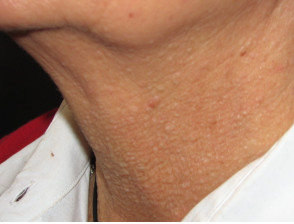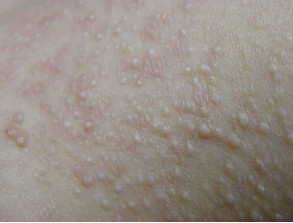Birt-Hogg-Dubé Syndrome (BHDS) Specimens
Bay Biosciences provides high quality, clinical grade bio-samples, cryogenically preserved biopsy tissue, FFPE blocks, sera (serum), plasma and peripheral blood mononuclear cells (PBMC) biofluid specimens from patients diagnosed with Birt-Hogg-Dubé Syndrome (BHDS).
The sera (serum), plasma and PBMC biofluid samples are processed from patient’s peripheral whole-blood using customized processing protocols. The Birt-Hogg-Dubé Syndrome (BHDS) bio-specimens are collected from unique patients diagnosed with Birt-Hogg-Dubé Syndrome (BHDS) and are provided to a valued pharmaceutical customer for translational research, genomics, proteomics and biomarker research, drug discovery and development.
Birt-Hogg-Dubé Syndrome (BHDS) Overview
Birt–Hogg–Dubé syndrome also known as Hornstein–Knickenberg Syndrome is a rare autosomal dominant genetic disorder, it is an inherited condition characterized by the development of benign tumors on the head, face and upper body. Birt–Hogg–Dubé Syndrome is also known as fibrofolliculoma with trichodiscoma and acrochordon.
Patients with Birt-Hogg-Dubé Syndrome are at increased risk of developing colon or kidney cancer as well as spontaneous pneumothorax (lung collapse) due to pulmonary (lung) cysts and noncancerous tumors of the hair follicles called fibrofolliculomas.
The benign skin tumors involved in Birt-Hogg-Dube Syndrome (BHDS) are:
- Fibrofolliculoma- Tumor developing in hair follicles
- Trichodiscoma- Tumor of the hair disc
- Angiofibroma- Vascular Tumor
- Acrochordon- Skin tags

Symptoms of Birt-Hogg-Dubé Syndrome (BHDS)
Painless, small, papular skin lesions develop gradually over the scalp, face, neck, chest and back in BHDS patients. Lesions usually develop at around age 30 or 40 years, although they have been found in younger patients also, and they are not always present in people with the abnormal BHD gene. The symptoms of Birt-Hogg-Dube Syndrome seen in each family are unique, and can include any combination of the three symptoms.
Fibrofolliculomas are the most common manifestation, found on the face and upper trunk in over 80% of the patients with BHDS over the age of 40. Pulmonary cysts are equally common in BHDS patients (around 85% of the patients). Only around 25% of people with BHD eventually experience a collapsed lung (spontaneous pneumothorax). Kidney tumors, both cancerous and benign, occur in 15–30 percent of the BHDS patients, the associated kidney cancer are often rare hybrid umors.
- Fibrofolliculomas (also called trichodiscomas) are small (2-4 mm), white-to-flesh colored, smooth, dome-shaped bumps.
- Acrochordons or skin tags are small, soft 1-2 mm bumps that look like a wart with a thin neck.
- There may be anywhere on the patients body from two to many hundreds of lesions.
- Once developed, skin lesions are permanent.
Oral mucosal polyps, collagenomas, angiolipomas, and deforming lipomas may also form in the BHDS patients.
Causes of Birt-Hogg-Dubé Syndrome (BHDS)
Birt–Hogg–Dubé syndrome (BHDS) is caused due to a mutation in the BHD or FLCN gene on chromosome 17p12-q11.2 encoding a protein called folliculin. It is not known why this mutation occurs. Though its function is not fully understood, it appears to be a tumor suppressor gene that restricts cell growth and division. The syndrome is an autosomal dominant condition meaning half of an affected person’s children have a risk of inheriting the mutation. Versions of FLCN gene have been found in other animals, including fruit flies, German shepherds, rats and mice.
Birt–Hogg–Dubé syndrome can manifest similarly to other diseases, which must be ruled out when making a diagnosis. These include tuberous sclerosis, which causes skin lesions similar to fibrofolliculomas, and Von Hippel-Lindau disease, which also causes hereditary kidney cancers.
FLCN gene creates a protein called folliculin that has two isoforms. It appears to act as a tumor suppressor and is expressed strongly in the skin, distal nephrons and Type-1 pneumocytes. It has also been found in the parotid gland, brain, breast, pancreas, prostate and ovaries. Tumor suppressors normally prevent cells from growing and dividing too rapidly or in an uncontrolled way. Mutations in the FLCN gene may interfere with the ability of folliculin to restrain cell growth and division, leading to the formation of noncancerous and cancerous tumors.

Etiology of Birt–Hogg–Dubé syndrome (BHDS)
Diagnostic methods of Birt–Hogg–Dubé syndrome (BHDS)
in the BHDS, FLCN gene.
Differential Diagnosis Birt–Hogg–Dubé Syndrome (BHSD)
Management and treatment of Birt–Hogg–Dubé Syndrome (BHDS)
Prognosis

Detailed clinical data, FLCN molecular genetic test, elevated biomarker levels, genetic and metabolic information, tumor tissue biopsy, pathology annotations associated with the Birt-Hogg-Dubé Syndrome (BHDS) patient’s specimens is provided to a valued customer for drug discover, development and research. The Birt-Hogg-Dubé Syndrome (BHDS) sera (serum), plasma and PBMC biofluid samples are processed from patients peripheral whole-blood using customized collection and processing protocols provided by the researcher.
Bay Biosciences is a global leader in providing researchers with high quality, clinical grade, fully characterized human tissue samples, bio-specimens and human bio-fluid collections from cancer (tumor) tissue, cancer sera (serum), cancer plasma, cancer PBMC and human tissue samples from most other therapeutic areas and diseases.
Bay Biosciences maintains and manages it’s own bio-repository, human tissue bank (biobank) consisting of thousands of diseased samples (specimens) and from normal healthy donors available in all formats and types. Our biobank procures and stores fully consented, deidentified and institutional review boards (IRB) approved human tissue samples and matched controls.
All our human human tissue collections, human specimens and human bio-fluids are provided with detailed samples associated patient’s clinical data. This critical patient’s clinical data includes information relating to their past and current disease, treatment history, lifestyle choices, biomarkers and genetic information. Patient’s data is extremely valuable for researchers and is used to help identify new effective treatments (drug discovery & development) in oncology, other therapeutic areas and diseases. This clinical information is critical to demonstrate their impact, monitor the safety of medicines, testing & diagnostics, and generate new knowledge about the causes of disease and illness.
Bay Biosciences banks wide variety of human tissue samples and biological samples including cryogenically preserved -80°C, fresh, fresh frozen tissue samples, tumor tissue samples, FFPE’s, tissue slides, with matching human bio-fluids, whole blood and blood derived products such as serum, plasma and PBMC’s.
Bay Biosciences is a global leader in collecting and providing human tissue samples according to the researchers specified requirements and customized, tailor made collection protocols. Please contact us anytime to discuss your special research projects and customized human tissue sample requirements.
Bay Biosciences provides human tissue samples (human specimens) from diseased and normal healthy donors; including peripheral whole-blood, amniotic fluid, bronchoalveolar lavage fluid (BAL), sputum, pleural effusion, cerebrospinal fluid (CSF), serum (sera), plasma, peripheral blood mononuclear cells (PBMC’s), saliva, Buffy coat, urine, stool samples, aqueous humor, vitreous humor, kidney stones, renal calculi, nephrolithiasis, urolithiasis and other bodily fluids from most diseases including cancer. We can also procure most human bio-specimens and can do special collections and requests of human samples that are difficult to find. All our human tissue samples are procured through IRB approved clinical protocols and procedures.
In addition to the standard processing protocols Bay Biosciences can also provide human plasma, serum, PBMC bio-fluid samples using custom processing protocols, you can buy donor specific sample collections in higher volumes and specified sample aliquoting from us.
Bay Biosciences also provides human samples from normal healthy donors, volunteers, for controls and clinical research, contact us Now.
日本のお客様は、ベイバイオサイエンスジャパンBay Biosciences Japan またはhttp://baybiosciences-jp.com/contact/までご連絡ください。


